Happy New Year! It’s hard to believe that a full year has passed since I began writing these messages as CEO of our statewide association of electric cooperatives. 2025 was a fulfilling year, filled with both highlights and challenges, and I’ve been grateful for the opportunity to share my thoughts and to reflect on our progress.
Up Front
Kyle Hicks, the new senior government affairs analyst at Ohio State University’s College of Food, Agricultural, and Environmental Sciences, hadn’t always planned to pursue a career in public policy — he wanted to be a teacher.
Hicks decided to apply to take the trip after hearing about the experiences his mom and sister had when they went on Youth Tour in 1994 and 2017, respectively. South Central Power selected him as one of its delegates as he was finishing his junior year at Amanda-Clearcreek High School, and that summer, he boarded a D.C.-bound bus with 30 other Ohio students who had been sponsored by their own co-ops.
December is a special time of year. The days may be shorter and colder, but there’s a lot to like. College and pro football start to get really interesting as rankings and playoff hopes take shape, and most of us aren’t too tired of the weather (yet). Christmas music can be heard everywhere, and for those of us who love it, especially the deep cuts or new songs just being released, it brings a lot of positive energy to the season. I look forward to discovering new Christmas music each year and love listening to favorites I haven’t heard for the last 11 months.
On Veterans Day, many people take time to thank those who served in the military. But for many veterans, the real thanks goes the other way — they are grateful they had the opportunity to serve their country, to be part of something meaningful, to grow as people, and to contribute to protecting the freedoms we all enjoy.
In an increasingly digital world, cybersecurity has become second nature to most of us. We lock our phones, use strong passwords, and enable two-factor authentication to protect our personal data. We’re alert for phishing attempts and digital scams that seek to exploit our trust or steal sensitive information. They’re practices that reflect a broader principle: securing what matters.
Farming has long been the backbone of Ohio’s economy. Even if you don’t farm today, you likely have friends or family who do, or ancestors who once did.
Ohio’s electric cooperatives have a long history with the farming community. Years ago, rural residents (many of them farmers) worked together to bring electricity to their homes and towns, changing life in the countryside forever.
Independence Day is a special time for Ohioans to honor the courage and hard work of our founding fathers, who overcame great struggles to create a nation where values like liberty, personal freedom, and self-governance could thrive. These same values continue to guide how Ohio’s electric cooperatives operate today.
June is that glorious month when we enjoy the longest days of the year. In fact, Ohioans get more than 15 hours of sunlight on several days surrounding the summer solstice later this month. In recent years, it’s also been a time when solar power draws significant attention as something that seems like an obvious solution to America’s ever-growing electricity needs.
But even as more electricity is added to the grid from solar resources, it’s important to understand that solar power alone cannot meet our nation’s electricity needs.
Electricity is truly remarkable. It’s everywhere — lighting up our homes, powering TVs and refrigerators, charging phones we rely on daily, and generally changing our lives in ways we almost take for granted. It feels like it’s always been here.
That’s not the case, of course. It’s worth remembering that, though electricity now runs almost every part of our routines, most homes and businesses in rural parts of the United States didn’t have electricity available to them until the mid-1930s.
















